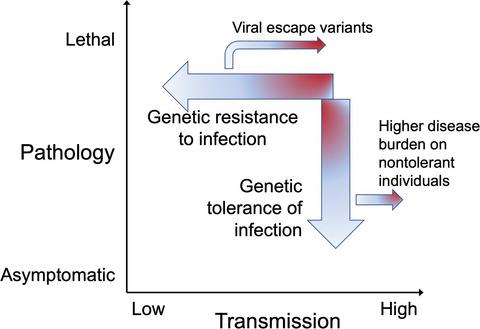当前位置:
X-MOL 学术
›
Immunol. Cell Biol.
›
论文详情
Our official English website, www.x-mol.net, welcomes your
feedback! (Note: you will need to create a separate account there.)
COVID‐19, varying genetic resistance to viral disease and immune tolerance checkpoints
Immunology and Cell Biology ( IF 3.2 ) Pub Date : 2020-10-28 , DOI: 10.1111/imcb.12419 Christopher C Goodnow 1, 2
Immunology and Cell Biology ( IF 3.2 ) Pub Date : 2020-10-28 , DOI: 10.1111/imcb.12419 Christopher C Goodnow 1, 2
Affiliation

|
Coronavirus disease 2019 (COVID‐19) is a zoonosis like most of the great plagues sculpting human history, from smallpox to pandemic influenza and human immunodeficiency virus. When viruses jump into a new species the outcome of infection ranges from asymptomatic to lethal, historically ascribed to “genetic resistance to viral disease.” People have exploited these differences for good and bad, for developing vaccines from cowpox and horsepox virus, controlling rabbit plagues with myxoma virus and introducing smallpox during colonization of America and Australia. Differences in resistance to viral disease are at the core of the severe acute respiratory syndrome coronavirus 2 (SARS‐CoV‐2) crisis, yet our understanding of the mechanisms in any interspecies leap falls short of the mark. Here I review how the two key parameters of viral disease are countered by fundamentally different genetic mechanisms for resistance: (1) virus transmission, countered primarily by activation of innate and adaptive immune responses; and (2) pathology, countered primarily by tolerance checkpoints to limit innate and adaptive immune responses. I discuss tolerance thresholds and the role of CD8 T cells to limit pathological immune responses, the problems posed by tolerant superspreaders and the signature coronavirus evasion strategy of eliciting only short‐lived neutralizing antibody responses. Pinpointing and targeting the mechanisms responsible for varying pathology and short‐lived antibody were beyond reach in previous zoonoses, but this time we are armed with genomic technologies and more knowledge of immune checkpoint genes. These known unknowns must now be tackled to solve the current COVID‐19 crisis and the inevitable zoonoses to follow.
中文翻译:

COVID-19,对病毒性疾病和免疫耐受性检查点的不同遗传抵抗力
冠状病毒病2019(COVID-19)是一种人畜共患病,就像雕刻人类历史的大多数大瘟疫一样,从天花到大流行性流感和人类免疫缺陷病毒。当病毒跳入一个新物种时,感染的结果从无症状到致命,从历史上讲归因于“对病毒性疾病的遗传抗性”。人们利用这些差异的好坏,开发牛痘和马痘病毒的疫苗,用粘液瘤病毒控制兔瘟,并在美国和澳大利亚殖民期间引入天花。对病毒性疾病的抵抗力差异是严重急性呼吸系统综合症冠状病毒2(SARS-CoV-2)危机的核心,但我们对任何种间飞跃机制的理解仍未达到目标。在这里,我回顾了如何通过根本不同的抗药性遗传机制来对抗病毒性疾病的两个关键参数:(1)病毒传播,主要通过激活先天性和适应性免疫应答来对抗;(2)病理,主要是通过耐受性检查点来限制固有和适应性免疫反应。我讨论了耐受性阈值和CD8 T细胞在限制病理性免疫反应中的作用,耐受性超级扩散蛋白所引起的问题以及仅引发短期中和抗体反应的标志性冠状病毒逃避策略。在以前的人畜共患病中,无法找到和靶向导致病理变化和抗体寿命短的机制,但是这次我们有了基因组技术和对免疫检查点基因的更多了解。
更新日期:2020-10-28
中文翻译:

COVID-19,对病毒性疾病和免疫耐受性检查点的不同遗传抵抗力
冠状病毒病2019(COVID-19)是一种人畜共患病,就像雕刻人类历史的大多数大瘟疫一样,从天花到大流行性流感和人类免疫缺陷病毒。当病毒跳入一个新物种时,感染的结果从无症状到致命,从历史上讲归因于“对病毒性疾病的遗传抗性”。人们利用这些差异的好坏,开发牛痘和马痘病毒的疫苗,用粘液瘤病毒控制兔瘟,并在美国和澳大利亚殖民期间引入天花。对病毒性疾病的抵抗力差异是严重急性呼吸系统综合症冠状病毒2(SARS-CoV-2)危机的核心,但我们对任何种间飞跃机制的理解仍未达到目标。在这里,我回顾了如何通过根本不同的抗药性遗传机制来对抗病毒性疾病的两个关键参数:(1)病毒传播,主要通过激活先天性和适应性免疫应答来对抗;(2)病理,主要是通过耐受性检查点来限制固有和适应性免疫反应。我讨论了耐受性阈值和CD8 T细胞在限制病理性免疫反应中的作用,耐受性超级扩散蛋白所引起的问题以及仅引发短期中和抗体反应的标志性冠状病毒逃避策略。在以前的人畜共患病中,无法找到和靶向导致病理变化和抗体寿命短的机制,但是这次我们有了基因组技术和对免疫检查点基因的更多了解。











































 京公网安备 11010802027423号
京公网安备 11010802027423号